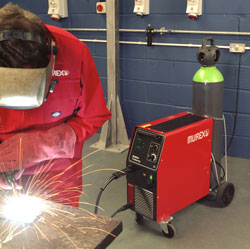
Posted to News on 30th Oct 2008, 20:32
An introduction to MIG welding
This article from Murex Welding Products outlines the MIG welding process and the types of application for which it is commonly used.

Metal inert gas welding, or MIG welding, is the most widely used of the arc welding processes. It is suitable for everything from hobbies and small fabrications or repairs, through to large structures, shipbuilding and robotic welding. MIG can be used on a broad range of materials and thicknesses, and the latest SuperPulse technology enables MIG to give a finish that is similar to that obtained with TIG (tungsten inert gas) welding, yet with the speed for which MIG is renowned.
The concept underlying MIG welding is simple, with the arc being struck between the tip of the reel-fed wire as it emerges from the torch, and the workpiece. A shielding gas prevents oxidation forming, or the use of some flux-cored wires avoids the need for a shielding gas. With most MIG welding sets, the user sets the wire feed speed, which determines the current; then the user sets the voltage to suit that current.
Ease of use is clearly a major benefit of MIG in many applications, but speed is also important. It is far quicker to lay down weld metal with MIG than TIG, MMA (manual metal arc - or 'stick' welding) or gas welding.
MIG applications
Typical applications for MIG welding include automotive sub-assemblies and bodywork, ranging from conventional MIG for most bodywork to heavy-duty MIG for lorry chassis and off-highway vehicles. Lower-current MIG brazing is used on thin-gauge, high-strength steels. MIG is also used extensively in automotive and general repair workshops. Other applications include: the assembly of white goods and office furniture; and structural steelwork for the construction industry, as well as bridges and, increasingly, wind turbine towers. MIG welding is widely used in shipbuilding and ship repair yards, and SuperPulse is often selected for the fabrication of yachts and other high-quality vessels. In the process industry MIG is used for pipework and the fabrication of vessels. It is also used if, for example, a vessel needs to be lined with a corrosion-resistant material such as Hastelloy.
Another application for which MIG is increasing in popularity is brazing. The main advantage of MIG brazing is that it enables good strength to be achieved when joining thin materials - even down to 0.5mm - hence it is increasingly popular in the automotive industry, where designers are seeking to reduce weight and design vehicle bodies in thinner grades of stronger steel. Welding such materials can lead to cracking in the heat-affected zone, whereas brazing puts less heat into the joint. The result is a joint with satisfactory strength and no undesirable affects in the parent metal.
Murex Welding Products offers a broad range of MIG welding machines with a choice of control panels, as well as accessories and equipment for automated or semi-automated welding. The range covers everything from lightweight, portable single-phase units rated at 100A, up to heavy-duty three-phase industrial machines rated up to 400A. Indeed, Murex can supply machines to suit almost any MIG application, and they are all featured in the company's new Guide to MIG Welding.
To request copies of the Murex Guide to MIG Welding, telephone +44 (0)800 3893152 or email [email protected].






























